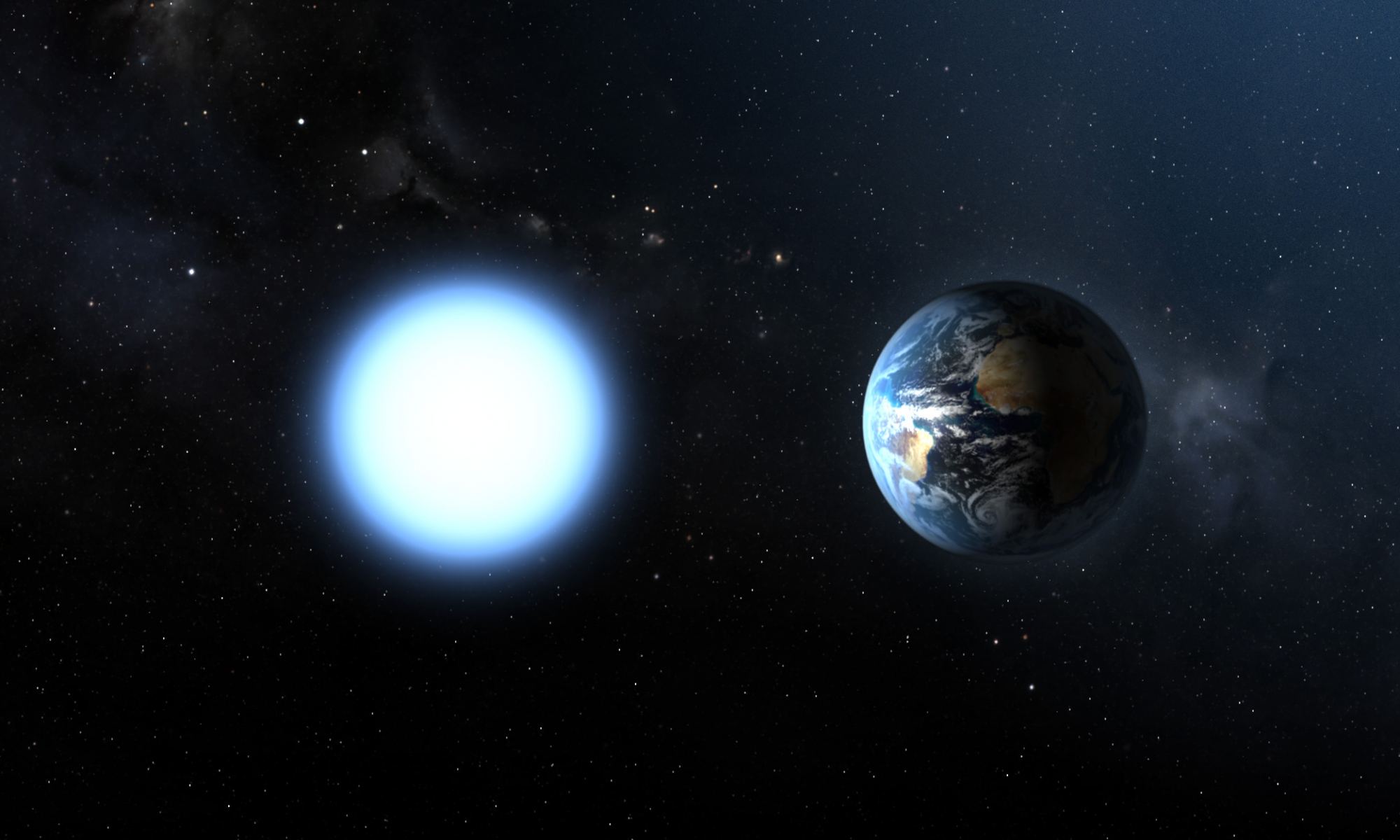As the search for dark matter particles continues to yield nothing, astronomers continue to look at ways these elusive particles might be found. One general method is to look for evidence of dark matter particle decay. Although dark matter doesn’t interact strongly with regular matter, some dark matter models predict that dark matter particles can interact with each other, causing them to decay into regular particles. There have been several searches for this effect, but there’s no clear evidence yet. But a new study suggests looking at white dwarfs could be a good approach.
Continue reading “Dark Matter Could Be Annihilating Inside White Dwarfs”Astronomers Have a New Way to Find Exoplanets in Cataclysmic Binary Systems
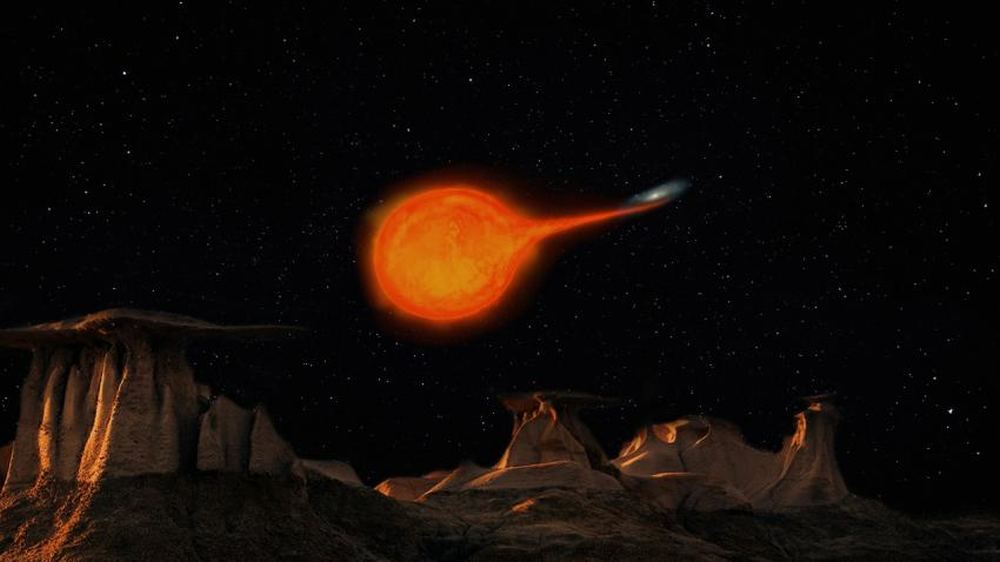
Have you heard of LU Camelopardalis, QZ Serpentis, V1007 Herculis and BK Lyncis? No, they’re not members of a boy band in ancient Rome. They’re Cataclysmic Variables, binary stars that are so close together one star draws material from its sibling. This causes the pair to vary wildly in brightness.
Can planets exist in this chaotic environment? Can we spot them? A new study answers yes to both.
Continue reading “Astronomers Have a New Way to Find Exoplanets in Cataclysmic Binary Systems”A New Kind of Stellar Explosion Has Been Discovered: Micronovae
The most energetic explosions in the Universe come from stars called supernovae. These galactic bombs have the energy of about 1028 mega-tons. After they detonate, the only thing left behind is either a neutron star or black hole. Another type of stellar explosion is known as a nova which has much less energy and covers the surface of a white dwarf.
Now, a team of astronomers recently discovered a new type of stellar explosion akin to supernovae and novae but with much less energy, and they’re calling it a micronova.
Continue reading “A New Kind of Stellar Explosion Has Been Discovered: Micronovae”Astronomers Watch a Nova Go From Start to Finish for the First Time
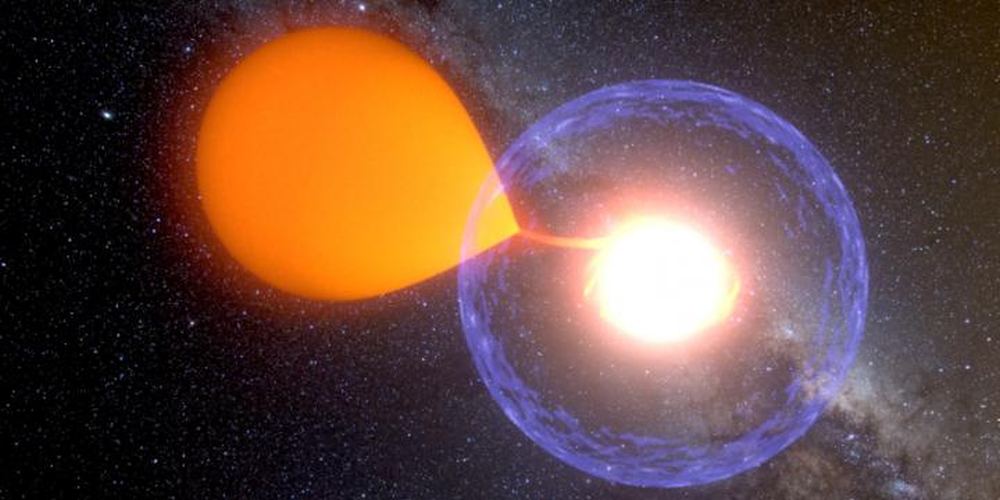
A nova is a dramatic episode in the life of a binary pair of stars. It’s an explosion of bright light that can last weeks or even months. And though they’re not exactly rare—there are about 10 each year in the Milky Way—astronomers have never watched one from start to finish.
Until now.
Continue reading “Astronomers Watch a Nova Go From Start to Finish for the First Time”Gaia Turns Up 13,928 White Dwarfs Nearby the Sun, Including Several Formed Through Mergers

In 2013, the European Space Agency (ESA) deployed the Gaia mission, a space observatory designed to measure the positions of movements of celestial bodies. For the past four years, Gaia has been studying distant stars, planets, comets, asteroids, quasars and other astronomical objects, and the data it has acquired will be used to construct the largest and most precise 3D space catalog ever made, totaling 1 billion objects.
The second release of Gaia data, which took place on April 25th, 2018, has already resulted in a number of impressive discoveries. The latest was made by an international team of scientists who identified 13,928 white dwarfs within 100 parsecs (326 light-years) of the Sun, many of which were formed through mergers. This is the first time that white dwarf stars have been directly detected within the Solar neighborhood.
The study which describes their findings, “Gaia Reveals Evidence for Merged White Dwarfs“, recently appeared online and is being considered for publication in the Monthly Notices of the Royal Astronomical Society. The study was led by Dr. Mukremin Kilic, an associate professor at the University of Oklahoma, and included members from the Institute for Astronomy at the University of Edinburgh and the University of Montreal.
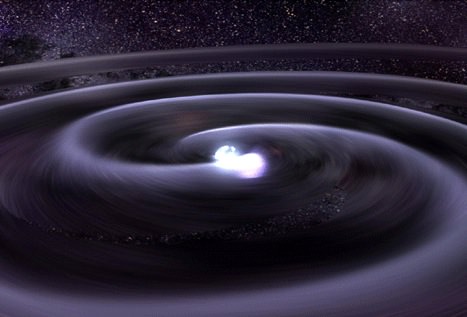
Basically, white dwarfs are what become of the majority of stars (with masses less than 8 Solar masses) once they exit the main sequence phase of their lives. This consists of a star exhausting its hydrogen fuel and expanding to several times its size (entering its Red Giant Branch Phase). These stars then blow off their external layers (a supernova) and leaving behind a white dwarf remnant.
By studying them, astronomers can learn far more about the life cycle of stars and how they evolve. As Dr. Kilic explained to Universe Today via email:
“[W]e’re basically doing Galactic archaeology when we study nearby white dwarfs. They tell us about the ages and star formation histories of the Galactic disk and halo. More importantly, white dwarfs explode as a Type Ia supernova when they reach 1.4 times the mass of the Sun. We use these supernovae to study the shape of the Universe and conclude that the expansion of the universe is accelerating. However, we have not yet found the progenitor systems of these supernovae. One of the channels to form Type Ia supernovae is through mergers of white dwarfs. Hence, the direct detection of merged white dwarfs is important for understanding the frequency of these white dwarf mergers.”
However, until recently only a few hundred white stars have been found within the local galactic neighborhood (500 within a 40 parsec radius). In addition, astronomers were only able to obtain accurate parallax (distance) measurements for about half of these. But thanks to the Gaia data, the number of white dwarfs systems that astronomers are able to study has increased exponentially.
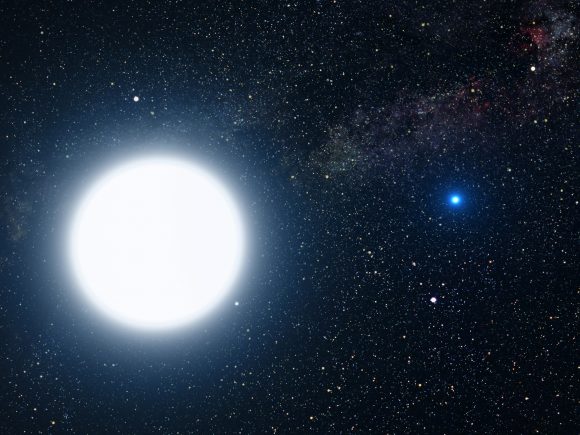
“Gaia provided distance measurements,” said Kilic. “We can now create complete samples of white dwarfs within a given volume. For example, prior to Gaia, we only knew about 100 white dwarfs within 20 parsecs of the Sun. With Gaia Data Release 2, we identified more than 13,000 white dwarfs within 100 parsecs of the Sun. The difference in numbers is amazing!”
The Gaia data was also helpful in determining the nature of these white dwarf systems and how they formed. As they indicate in their study, previous research has shown that the majority of white dwarf stars in our local galaxy (roughly 56%) are the product of single-star evolution, whereas 7 to 23% were the product of mergers between binaries. The remainder were white dwarf binaries, or binaries with one white dwarf and a main sequence star.
Using the Gaia data – which included the color and distribution data of thousands of white dwarf stars within ~326 light-years of the Sun – the team was able to determine how massive these stars are. This, in turn, provided vital clues as to how they formed, which indicated that mergers were far more common than previous studies suggested. As Kilic explained:
“Massive white dwarfs tend to be smaller, which means that they are also fainter (since they have a smaller surface area). Since Gaia gave us a complete sample of white dwarfs within 100 parsecs of the Sun, for the first time, we were able to derive the magnitude distribution (hence the mass distribution) of thousands of white dwarfs and find a large fraction of massive white dwarfs. We see that the number of massive white dwarfs is significantly higher than expected from single star evolution. Therefore, we concluded that many of these massive white dwarfs actually formed through mergers in previously binary systems.”
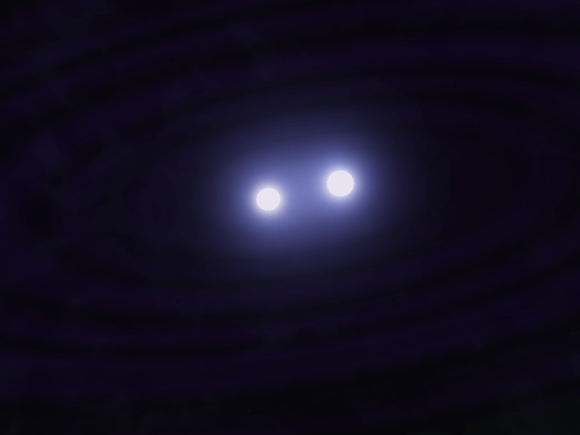
From this, the team was able to assemble the first reliable Hertzsprung-Russell Diagram for nearby field white dwarf stars, as well as estimates on how often white dwarf binaries merge. As Kilic indicated, this could have significant implications for other areas of astronomical study.
“Based on the frequency of these single white dwarfs that formed through mergers, we can estimate how many white dwarf mergers occur on average and with what mass distribution,” he said. “We can then infer the rate of Type Ia supernovae from these mergers and see if it’s enough to explain part or all of the Ia supernova explosions. This is an ongoing area of research and I’m sure we will some results on these very soon.”
These findings are yet another gem to come from the second Gaia data release, which has proven to be a treasure trove for astronomers. The third release of Gaia data is scheduled to take place in late 2020, with the final catalog being published in the 2020s. Meanwhile, an extension has already been approved for the Gaia mission, which will now remain in operation until the end of 2020 (to be confirmed at the end of this year).
Further Reading: arXiv
Evidence for Thousands of Black Holes Buzzing Around the Center of the Milky Way

Since the 1970s, astronomers have understood that a Supermassive Black Hole (SMBH) resides at the center of the Milky Way Galaxy. Located about 26,000 light-years from Earth between the Sagittarius and Scorpius constellations, this black hole has come to be known as Sagittarius A* (Sgr A*). Measuring 44 million km across, this object is roughly 4 million times as massive as our Sun and exerts a tremendous gravitational pull.
Since that time, astronomers have discovered that most massive galaxies have SMBHs at their core, which is what separates those that have an Active Galactic Nuclei (AGN) from those that don’t. But thanks to a recent survey conducted using NASA’s Chandra X-ray Observatory, astronomers have discovered evidence for hundreds or even thousands of black holes located near the center of the Milky Way Galaxy.
The study which described their findings was recently published in the journal Nature under the title “A density cusp of quiescent X-ray binaries in the central parsec of the Galaxy“. The study was led by Chuck Hailey, the Pupin Professor of Physics and the Co-Director of the Columbia Astrophysics Laboratory (CAL) at Columbia University, and including members from the Instituto de Astrofísica at the Pontificia Universidad Católica de Chile and the Harvard-Smithsonian Center for Astrophysics.

Using Chandra data, the team searched for X-ray binaries containing black holes that were in the vicinity of Sgr A*. To recap, black holes are not detectable in visible light. However, black holes (or neutron stars) that are locked in close orbits with a star will pull material from their companions, which will then be accreted onto the black holes’ disks and heated up to millions of degrees.
This will result in the release of X-rays which can then be detected, hence why these systems are called “X-ray binaries”. Using Chandra data, the team sought out X-ray of sources that were located within roughly 12 light years of Sgr A*. They then selected sources with X-ray spectra similar to those of known X-ray binaries, which emit relatively large amounts of low-energy X-rays.
Using this method, they detected fourteen X-ray binaries within about three light years of Sgr A*, all of which contained stellar-mass black holes (between 5 and 30 times the mass of our Sun). Two of these sources had been identified by previous studies and were eliminated from the analysis, while the remaining twelve (circled in red in the image above) were newly-discovered.
Other sources which relatively large amounts of high energy X-rays (labeled in yellow) were believed to be binaries containing white dwarfs. Hailey and his colleagues concluded that the majority of the dozen X-ray binaries were likely to contain black holes, based on their variability and the fact that their X-ray emissions over the course of several years was different from what is expected from binaries containing neutron stars.
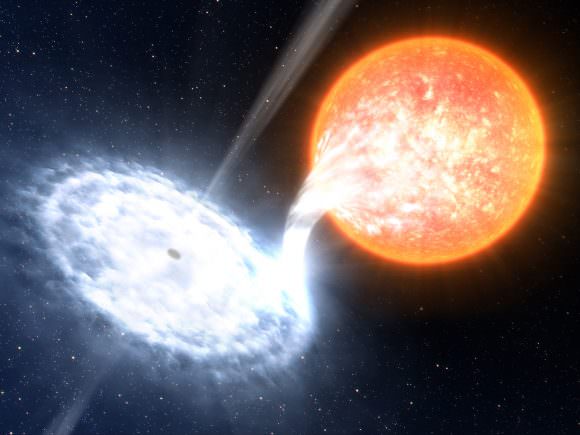
Given that only the brightest X-ray binaries containing black holes are likely to be detectable around Sgr A* (given its distance from Earth), Hailey and his colleagues concluded that this detection implies the existence of a much larger population. By their estimates, there could be at least 300 and as many as one thousand stellar-mass black holes present around Sgr A*.
These findings confirmed what theoretical studies on the dynamics of stars in galaxies have indicated in the past. According to these studies, a large population of stellar mass black holes (as many as 20,000) could drift inward over the course of millions of years and collect around an SMBH. However, the recent analysis conducted by Hailey and his colleagues was the first observational evidence of black holes congregating near Sgr A*.
Naturally, the authors acknowledge that there are other explanations for the X-ray emissions they detected. This includes the possibility that half of the dozen sources they observed are millisecond pulsars – very rapidly rotating neutron stars with strong magnetic fields. However, based on their observations, Hailey and his team strongly favor the black hole explanation.
In addition, a follow-up study conducted by Aleksey Generozov (et al.) of Columbia University – titled “An Overabundance of Black Hole X-Ray Binaries in the Galactic Center from Tidal Captures” – indicated that there could be as many as 10,000 to 40,000 black holes binaries at the center of our galaxy. According to this study, these binaries would be the result of companions being captured by black holes.

In addition to revealing much about the dynamics of stars in our galaxy, this study has implications for the emerging field of gravitational wave (GW) research. Essentially, by knowing how many black holes reside at the center of galaxies (which will periodically merge with one another), astronomers will be able to better predict how many gravitational wave events are associated with them.
From this, astronomers could create predictive models about when and how GW events are likely to happen, and well as discerning what role they may play in galactic evolution. And with next-generation instruments – like the James Webb Space Telescope (JWST) and the ESA’s Advanced Telescope for High Energy Astrophysics (ATHENA) – astronomers will be able to determine exactly how many black holes reside near the center of our galaxy.
Further Reading: NASA
Closest Star Around A Black Hole Discovered
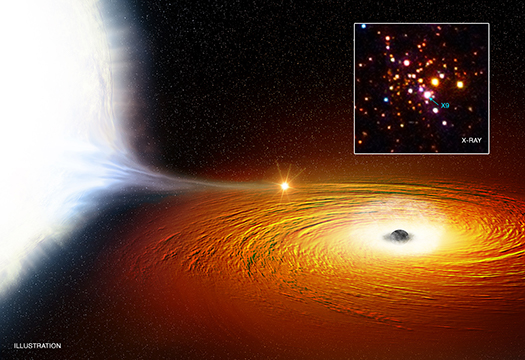
Imagine being caught in the clutches of a black hole, being whirled around at dizzying speeds and having your mass slowly but continually sucked away. That’s the life of a white dwarf star that is doing an orbital dance with a black hole. And this dancing duo could be the first ultracompact black hole X-ray binary identified in our galaxy.
“This white dwarf is so close to the black hole that material is being pulled away from the star and dumped onto a disk of matter around the black hole before falling in,” said Arash Bahramian from the University of Alberta in Edmonton, Canada, and Michigan State University, first author of a new paper.
If you were the white dwarf in this predicament, you may wish for a quick end to it all. But somehow, the star does not appear to be in danger of falling in or being torn apart by the black hole.
“We don’t think it will follow a path into oblivion, but instead will stay in orbit,” Bahramian added.
Data from the Chandra X-ray Observatory, the NuSTAR mission and the Australian Telescope Compact Array (ATCA) shows evidence that this star whips around the black hole about twice an hour, and it may be the tightest orbital dance ever witnessed for a likely black hole and a companion star.
This seemingly unique binary system – with a great name, X9 — is located in the globular cluster 47 Tucanae, a dense cluster of stars in our galaxy about 14,800 light years from Earth.
Astronomers have been studying this system for a while.
“For a long time, it was thought that X9 is made up of a white dwarf pulling matter from a low mass Sun-like star,” Bahramian wrote in a blog post.
But 2015, radio observations with the ATCA showed the pair likely contains a black hole pulling material from a companion star called a white dwarf, a low-mass star that has exhausted most or all of its nuclear fuel.
“In 2015, Dr. Miller-Jones and collaborators observed strong radio emission from X9 indicating the presence of a black hole in this binary,” Bahramian continued. “They suggested that this might mean the system is made up of a black hole pulling matter from a white dwarf.”
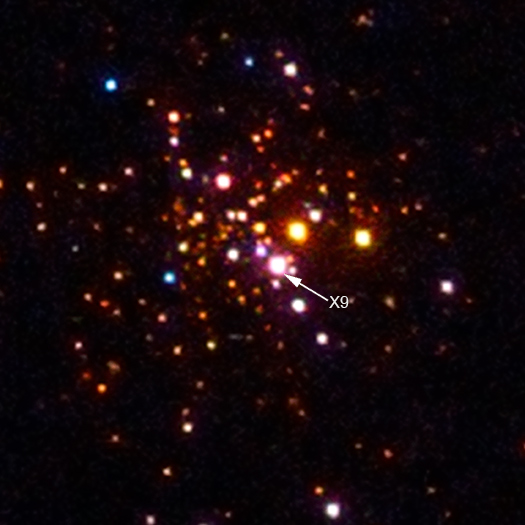
Looking at archived Chandra data, it showed changes in X-ray brightness in the same manner every 28 minutes, and Bahramian and his PhD supervisor Craig Heink think this is likely the length of time it takes the companion star to make one complete orbit around the black hole. Chandra data also shows evidence for large amounts of oxygen in the system, a characteristic feature of white dwarfs. They feel a strong case can be made that the companion star is a white dwarf. And this star would then be orbiting the black hole at just 2.5 times the distance between the Earth and the Moon.
“Eventually so much matter may be pulled away from the white dwarf that it ends up only having the mass of a planet,” said Heinke, also of the University of Alberta. “If it keeps losing mass, the white dwarf may completely evaporate.”
The researchers think this system would be a good candidate for future gravitational wave observatories to observe. It has to low of a frequency that is too low to be detected with Laser Interferometer Gravitational-Wave Observatory, LIGO, that made ground-breaking detections of gravitational waves last year. Systems like this could tell us more about gravitational waves, as well as providing more information about black hole binary systems.
“We’re going to watch this binary closely in the future, since we know little about how such an extreme system should behave”, said co-author Vlad Tudor of Curtin University and the International Centre for Radio Astronomy Research in Perth, Australia. “We’re also going to keep studying globular clusters in our galaxy to see if more evidence for very tight black hole binaries can be found.”
Further reading:
Chandra press release
ICRAR press release
Blog post
Paper: The ultracompact nature of the black hole candidate X-ray binary 47 Tuc X9
What Strange Places Are Habitable?
Everywhere we look on Earth, we find life. Even in the strangest corners of planet. What other places in the Universe might be habitable?
There’s life here on Earth, but what other places could there be life? This could be life that we might recognize, and maybe even life as we don’t understand it.
People always accuse me of being closed minded towards the search for life. Why do I always want there to be an energy source and liquid water? Why am I so hydrocentric? Scientists understand how life works here on Earth. Wherever we find liquid water, we find life: under glaciers, in your armpits, hydrothermal vents, in acidic water, up your nose, etc.
Water acts as a solvent, a place where atoms can be moved around and built into new structures by life forms. It makes sense to search for liquid water as it always seems to have life here. So where could we go searching for liquid water in the rest of the Universe?
Under the surface of Europa, there are deep oceans. They’re warmed by the gravitational interactions of Jupiter tidally flexing the surface of the moon. There could be life huddled around volcanic vents within its ocean. There’s a similar situation in Saturn’s Moon Enceladus, which is spewing out water ice into space; there might be vast reserves of liquid water underneath its surface. You could imagine a habitable moon orbiting a gas giant in another star system, or maybe you can just let George Lucas imagine it for you and fill it with Ewoks.

Let’s look further afield. What about dying white dwarf stars? Even though their main sequence days are over, they’re still giving off a lot of energy, and will slowly cool down over the coming billions of years. Brown dwarfs could get in on this action as well. Even though they never had enough mass to ignite solar fusion, they’re still generating heat. This could provide a safe warm place for planets to harbor life.
It gets a little trickier in either of these systems. White and brown dwarfs would have very narrow habitable zones, maybe 1/100th the size of the one in our Solar System. And it might shift too quickly for life to get started or survive for very long. This is our view, what we know life to be with water as a solvent. But astrobiologists have found other liquids that might work well as solvents too.

What about life forms that live in oceans of liquid methane on Titan, or creatures that use silicon or boron instead of carbon. It might just not be science fiction after all. It’s a vast Universe out there, stranger than we can imagine. Astronomers are looking for life wherever makes sense – wherever there’s liquid water. And if they don’t find any there, they’ll start looking places that don’t make sense.
What do you think? When we first find life, what will be its core building block? Silicon? Boron? or something even more exotic?
And if you like what you see, come check out our Patreon page and find out how you can get these videos early while helping us bring you more great content!
Rare White Dwarf Systems Do A Doubletake
For those of us who remain forever fascinated by astronomy, nothing could spark our imaginations more than a cosmic curiosity. In this case, the unusual object is a star cataloged as AM Canum Venaticorum (AM CVn) located in the constellation of Canes Venatici. What makes this dual star system of interest? Try the fact that the pair revolve completely around each other in a brief 18 minutes. What’s more, they are the stuff of which Einstein dreamed… creators of ripples in space-time known as gravitational waves.
Like other astronomical anomalies, AM CVn became the forerunner of a new class of stellar objects. It is a white dwarf, a sun-like star which has exhausted its fuel and collapsed to around the size of Earth. Yet it also has a white dwarf companion – a very compact orb which is delivering matter to its neighbor. AM Canum Venaticorum is not alone, however. There are similar systems where the stellar pairs complete their rotations in about an hour and even as rapidly as five minutes! Can you imagine the crackling amount of energy a system like this produces?!
Even though we have been aware of systems like AM CVn for almost five decades, no one is quite sure how they originate. Now, through the use of X-ray and optical observations, astronomers are taking a look at newly evolved double stars systems which one day might become a dueling duo dwarf. Heading their list are two binary systems, J0751 and J1741. These candidates were observed in the X-ray part of the electromagnetic spectrum by NASA’s Chandra X-ray Observatory and ESA’s XMM-Newton telescope. In addition, observations at optical wavelengths were made using the McDonald Observatory’s 2.1-meter telescope in Texas, and the Mt. John Observatory 1.0-meter telescope in New Zealand.
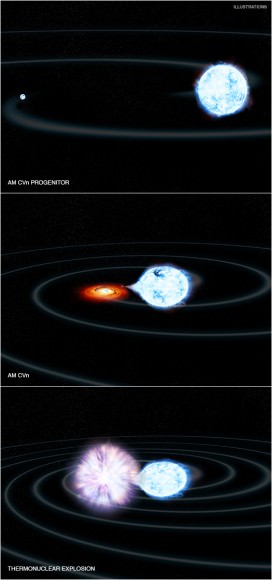 “The artist’s illustration depicts what these systems are like now and what may happen to them in the future. The top panel shows the current state of the binary that contains one white dwarf (on the right) with about one-fifth the mass of the Sun and another much heavier and more compact white dwarf about five or more times as massive (unlike Sun-like stars, heavier white dwarfs are smaller).” says the Chandra X-ray Observatory news release.
“The artist’s illustration depicts what these systems are like now and what may happen to them in the future. The top panel shows the current state of the binary that contains one white dwarf (on the right) with about one-fifth the mass of the Sun and another much heavier and more compact white dwarf about five or more times as massive (unlike Sun-like stars, heavier white dwarfs are smaller).” says the Chandra X-ray Observatory news release.
What’s happening here? As the pair of white dwarf stars whip around each other, they are releasing gravitational waves which constrict the orbit. In time, the heavier, diminutive dwarf will begin stripping material from its lighter, larger companion (as seen in the middle panel). This material consumption will continue for perhaps a 100 million years, or until the collected matter reaches a critical mass and releases a thermonuclear explosion.
Another scenario is the thermonuclear explosion could annihilate the larger white dwarf completely in what astronomers call a Type Ia supernova. An event like this is well-known and gives a measurement in standard candles for cosmic distance. However, chances are better the explosion will happen on the surface of the star – an event known as .Ia supernovae. While .Ia supernovae events have been recorded in other galaxies, J0751 and J1741 are the first binary stars which have the potential to erupt in .Ia supernovae.
“The optical observations were critical in identifying the two white dwarfs in these systems and ascertaining their masses. The X-ray observations were needed to rule out the possibility that J0751 and J1741 contained neutron stars.” says the Chandra team. “A neutron star – which would disqualify it from being a possible parent to an AM CVn system – would give off strong X-ray emission due to its magnetic field and rapid rotation. Neither Chandra nor XMM-Newton detected any X-rays from these systems.”
Are AM CVn systems riding the gravitational wave? While astronomers haven’t been able to detect them yet, these new observations are highly important because equipment to verify their presences is currently being developed. It won’t be long until we can see the wave and have a whole new way of looking at the Universe!
Original Story Source: Chandra Observatory News Release.
Hubble Observes Planet-“Polluted” Dead Stars In Hyades
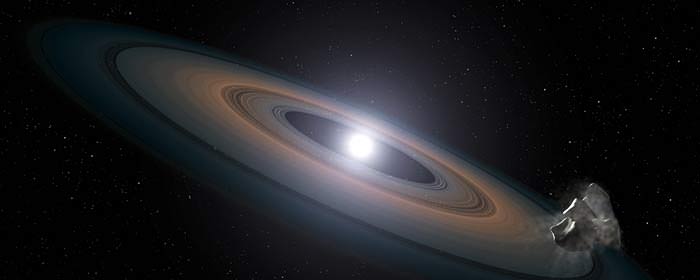
For those of us who practice amateur astronomy, we’re very familiar with the 150 light-year distant Hyades star cluster – one of the jewels in the Taurus crown. We’ve looked at it countless times, but now the NASA/ESA Hubble Space Telescope has taken its turn observing and spotted something astronomers weren’t expecting – the debris of Earth-like planets orbiting white dwarf stars. Are these “burn outs” being polluted by detritus similar to asteroids? According to researchers, this new observation could mean that rocky planet creation is commonplace in star clusters.
“We have identified chemical evidence for the building blocks of rocky planets,” said Jay Farihi of the University of Cambridge in England. He is lead author of a new study appearing in the Monthly Notices of the Royal Astronomical Society. “When these stars were born, they built planets, and there’s a good chance they currently retain some of them. The material we are seeing is evidence of this. The debris is at least as rocky as the most primitive terrestrial bodies in our solar system.”
So what makes this an uncommon occurrence? Research tells us that all stars are formed in clusters, and we know that planets form around stars. However, the equation doesn’t go hand in hand. Out of the hundreds of known exoplanets, only four are known to have homes in star clusters. As a matter of fact, that number is a meager half percent, but why? As a rule, the stars contained within a cluster are young and active. They are busy producing stellar flares and similar brilliant activity which may mask signs of emerging planets. This new research is looking to the “older” members of the cluster stars – the grandparents which may be babysitting.
To locate possible candidates, astronomers have employed Hubble’s Cosmic Origins Spectrograph and focused on two white dwarf stars. Their return showed evidence of silicon and just slight levels of carbon in their atmospheres. This observation was important because silicon is key in rocky materials – a prime ingredient on Earth’s list and other similar solid planets. This silicon signature may have come from the disintegration of asteroids as they wandered too close to the stars and were torn apart. A lack of carbon is equally exciting because, while it helps shape the properties and origins of planetary debris, it becomes scarce when rocky planets are formed. This material may have formed a torus around the defunct stars which then drew the matter towards them.
“We have identified chemical evidence for the building blocks of rocky planets,” said Farihi. “When these stars were born, they built planets, and there’s a good chance they currently retain some of them. The material we are seeing is evidence of this. The debris is at least as rocky as the most primitive terrestrial bodies in our solar system.”
Ring around the rosie? You bet. This leftover material swirling around the white dwarf stars could mean that planet formation happened almost simultaneously as the stars were born. At their collapse, the surviving gas giants may have had the gravitational “push” to relocate asteroid-like bodies into “star-grazing orbits”.

Inset, the locations of these white dwarf stars are indicated — stars known as WD 0421+162, and WD 0431+126. Credit: NASA, ESA, STScI, and Z. Levay (STScI)
“We have identified chemical evidence for the building blocks of rocky planets,” explains Farihi. “When these stars were born, they built planets, and there’s a good chance that they currently retain some of them. The signs of rocky debris we are seeing are evidence of this — it is at least as rocky as the most primitive terrestrial bodies in our Solar System. The one thing the white dwarf pollution technique gives us that we won’t get with any other planet detection technique is the chemistry of solid planets. Based on the silicon-to-carbon ratio in our study, for example, we can actually say that this material is basically Earth-like.”
What of future plans? According to Farihi and the research team, by continuing to observe with methods like those employed by Hubble, they can take an even deeper look at the atmospheres around white dwarf stars. They will be searching for signs of solid planet “pollution” – exploring the white dwarf chemistry and analyzing stellar composition. Right now, the two “polluted” Hyades white dwarfs are just a small segment of more than a hundred future candidates which will be studied by a team led by Boris Gansicke of the University of Warwick in England. Team member Detlev Koester of the University of Kiel in Germany is also contributing by using sophisticated computer models of white dwarf atmospheres to determine the abundances of various elements that can be traced to planets in the Hubble spectrograph data.
“Normally, white dwarfs are like blank pieces of paper, containing only the light elements hydrogen and helium,” Farihi said. “Heavy elements like silicon and carbon sink to the core. The one thing the white dwarf pollution technique gives us that we just won’t get with any other planet-detection technique is the chemistry of solid planets.”
The team also plans to look deeper into the stellar composition as well. “The beauty of this technique is that whatever the Universe is doing, we’ll be able to measure it,” Farihi said. “We have been using the Solar System as a kind of map, but we don’t know what the rest of the Universe does. Hopefully with Hubble and its powerful ultraviolet-light spectrograph COS, and with the upcoming ground-based 30- and 40-metre telescopes, we’ll be able to tell more of the story.”
And we’ll be listening…
Original Story Source: Hubble News Release.

